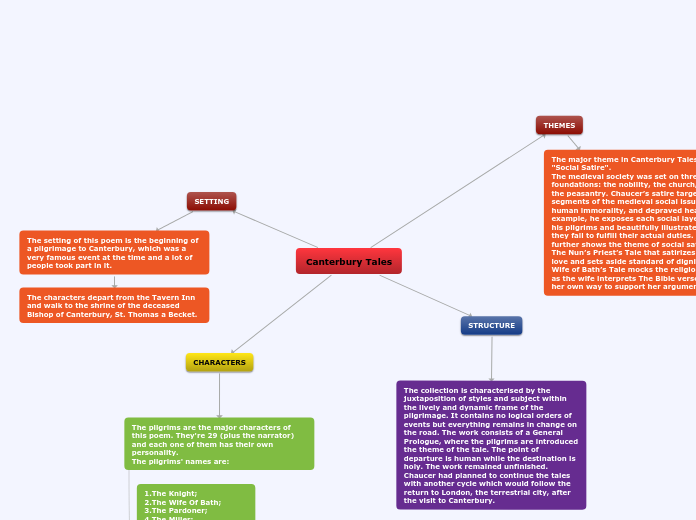Canterbury Tales
SETTING
The setting of this poem is the beginning of a pilgrimage to Canterbury, which was a very famous event at the time and a lot of people took part in it.
The characters depart from the Tavern Inn and walk to the shrine of the deceased Bishop of Canterbury, St. Thomas a Becket.
CHARACTERS
The pilgrims are the major characters of this poem. They're 29 (plus the narrator) and each one of them has their own personality.
The pilgrims' names are:
1.The Knight;
2.The Wife Of Bath;
3.The Pardoner;
4.The Miller;
5.The Prioress;
6.The Monk;
7.The Friar;
8.The Summoner;
9.The Host;
10.The Parson;
11.The Squire;
12.The Clerk;
13.The Man Of Law;
14.The Manciple;
15.The Merchant;
16.The Shipman;
17.The Physician;
18.The Franklin;
19.The Reeve;
20.The Plowman;
21.The Guildsmen;
22.The Cook;
23.The Knight's Yeoman;
24.The Second Nun;
25.The Nun’s Priest;
26.The Five craft workers;
27.The Canon;
28.The Canon's Yeoman;
STRUCTURE
The collection is characterised by the juxtaposition of styles and subject within the lively and dynamic frame of the pilgrimage. It contains no logical orders of events but everything remains in change on the road. The work consists of a General Prologue, where the pilgrims are introduced the theme of the tale. The point of departure is human while the destination is holy. The work remained unfinished. Chaucer had planned to continue the tales with another cycle which would follow the return to London, the terrestrial city, after the visit to Canterbury.
THEMES
The major theme in Canterbury Tales is "Social Satire".
The medieval society was set on three foundations: the nobility, the church, and the peasantry. Chaucer’s satire targets all segments of the medieval social issues, human immorality, and depraved heart. For example, he exposes each social layers of his pilgrims and beautifully illustrates how they fail to fulfill their actual duties. He further shows the theme of social satire in The Nun’s Priest’s Tale that satirizes courtly love and sets aside standard of dignity. The Wife of Bath’s Tale mocks the religious logic as the wife interprets The Bible verses in her own way to support her argument.
The other themes are:
-Courtly Love and Sexual Desire;
-Corruption in Church;
-Competition;
-Christianity;
-Class;
-Lies and Deception;
-Justice and Judgement;
-Rivalry;
-Company.
